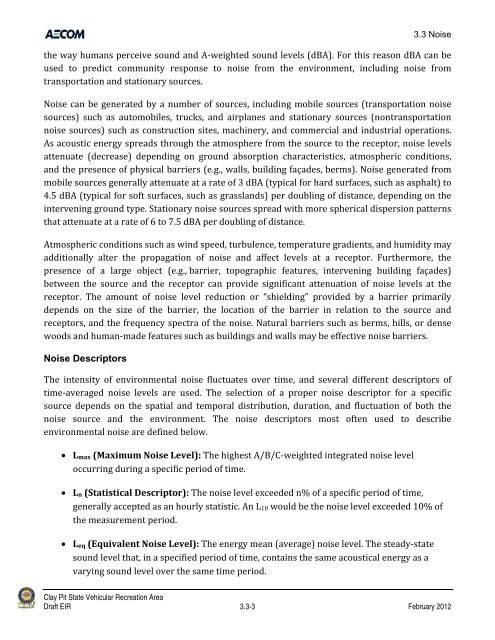Draft Environmental Impact Report - California Off Highway Vehicle ...
Draft Environmental Impact Report - California Off Highway Vehicle ...
Draft Environmental Impact Report - California Off Highway Vehicle ...
You also want an ePaper? Increase the reach of your titles
YUMPU automatically turns print PDFs into web optimized ePapers that Google loves.
3.3 Noise<br />
the way humans perceive sound and A‐weighted sound levels (dBA). For this reason dBA can be<br />
used to predict community response to noise from the environment, including noise from<br />
transportation and stationary sources.<br />
Noise can be generated by a number of sources, including mobile sources (transportation noise<br />
sources) such as automobiles, trucks, and airplanes and stationary sources (nontransportation<br />
noise sources) such as construction sites, machinery, and commercial and industrial operations.<br />
As acoustic energy spreads through the atmosphere from the source to the receptor, noise levels<br />
attenuate (decrease) depending on ground absorption characteristics, atmospheric conditions,<br />
and the presence of physical barriers (e.g., walls, building façades, berms). Noise generated from<br />
mobile sources generally attenuate at a rate of 3 dBA (typical for hard surfaces, such as asphalt) to<br />
4.5 dBA (typical for soft surfaces, such as grasslands) per doubling of distance, depending on the<br />
intervening ground type. Stationary noise sources spread with more spherical dispersion patterns<br />
that attenuate at a rate of 6 to 7.5 dBA per doubling of distance.<br />
Atmospheric conditions such as wind speed, turbulence, temperature gradients, and humidity may<br />
additionally alter the propagation of noise and affect levels at a receptor. Furthermore, the<br />
presence of a large object (e.g., barrier, topographic features, intervening building façades)<br />
between the source and the receptor can provide significant attenuation of noise levels at the<br />
receptor. The amount of noise level reduction or “shielding” provided by a barrier primarily<br />
depends on the size of the barrier, the location of the barrier in relation to the source and<br />
receptors, and the frequency spectra of the noise. Natural barriers such as berms, hills, or dense<br />
woods and human‐made features such as buildings and walls may be effective noise barriers.<br />
Noise Descriptors<br />
The intensity of environmental noise fluctuates over time, and several different descriptors of<br />
time‐averaged noise levels are used. The selection of a proper noise descriptor for a specific<br />
source depends on the spatial and temporal distribution, duration, and fluctuation of both the<br />
noise source and the environment. The noise descriptors most often used to describe<br />
environmental noise are defined below.<br />
Lmax (Maximum Noise Level): The highest A/B/C‐weighted integrated noise level<br />
occurring during a specific period of time.<br />
Ln (Statistical Descriptor): The noise level exceeded n% of a specific period of time,<br />
generally accepted as an hourly statistic. An L10 would be the noise level exceeded 10% of<br />
the measurement period.<br />
Leq (Equivalent Noise Level): The energy mean (average) noise level. The steady‐state<br />
sound level that, in a specified period of time, contains the same acoustical energy as a<br />
varying sound level over the same time period.<br />
Clay Pit State Vehicular Recreation Area<br />
<strong>Draft</strong> EIR 3.3-3 February 2012








